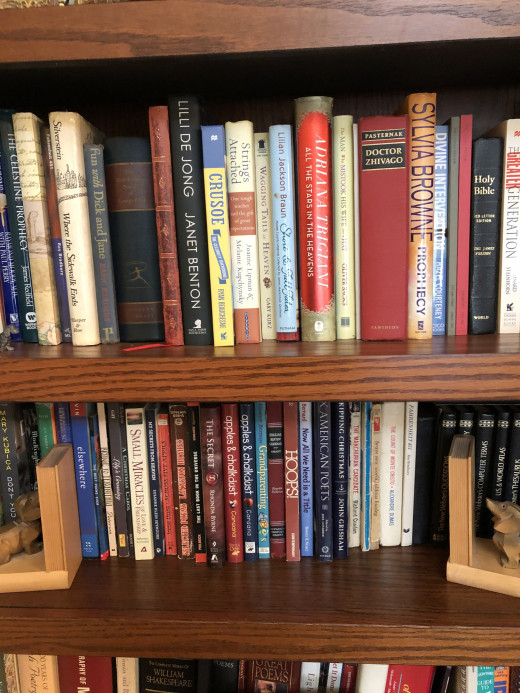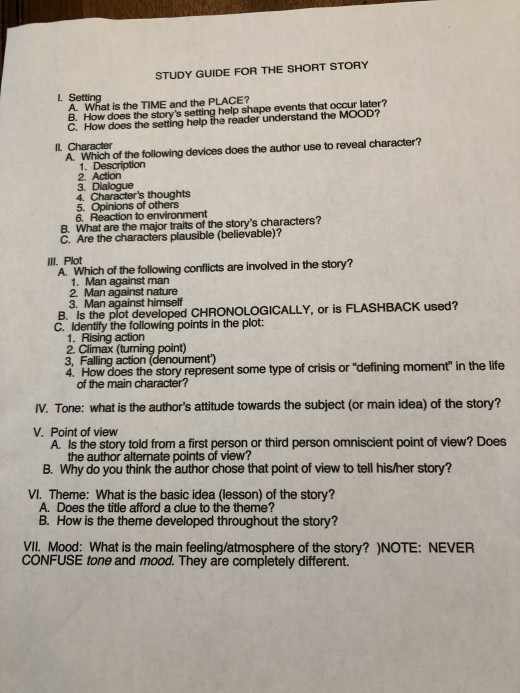- HubPages»
- Books, Literature, and Writing»
- Commercial & Creative Writing»
- Creative Writing
Boredom Be Gone: Lesson 7- Study Guide For the Short Story

Preparing to Read a Novel
Considering the fact that most of us are currently quarantined thanks to the COVID-19 pandemic, which seems at the very least surreal, I thought that it might be appropriate to read and discuss the science-fiction novel 1984. Before doing that, though, you’ll have to find a copy of the novel, which I’m fairly sure can be done online. I’ll publish my study guide for the book somewhere around Lesson 11.
In this online lesson, I’m going to give you a guide on reading and understanding a short story. They should provide a smooth transition to the novel. All you need to do is read a short story that you’ve never read before;mafter you read it, complete the Study Guide For the Short Story that appears below.
Here are some short story suggestions:
”The Telltale Heart”, by Edgar Allan Poe
”Raymond’s Run”, But Toni Cade Bambara
”The Gift of the Magi”, O. Henry
”Flowers For Algernon”, by Daniel Keyes (this one’s a little longer, but it’s my all-time favorite short story.)
Study Guide For the Short Story
I. Setting
A. Identify the TIME (1926; summer) and the PLACE (Chicago; an apartment; a school)
B. How does the stories setting help shape events that occur later?
C. How does the setting help the reader understand the MOOD?
II. Character
A. Which of the following devices does the author use to reveal character?
1. Description
2. Action
3. Dialogue
4. Character’s thoughts
5. Opinions of others
6. Reaction to environment
B. What are the major traits of the story’s characters?
C. are the characters plausible(believable)?
III. Plot
A. Which of the following conflicts are involved in the story?
1. Man against man (e.g.: two individuals are pitted against one another)
2. Man against nature (e.g.: The tornado has just hit a certain city)
3. Man against himself (e.g.: A young man is involved in something that his conscience tells him is wrong)
B. Is the plot developed CHRONOLOGICALLY (in order of time) or is FLASHBACK used?
C. Identify the following points in the plot:
1. Rising action (action leading up to the climax)
2. Climax (turning point)
3. Falling action (also called ”denouement’)
4. How does the story represent some type of crisis or “defining moment” in the life of the main character(s)?
IV. Tone: what is the authors attitude towards the subject (or main idea) of the story?
V. Point of view
A. Is the story told from the first person (“I”) or third person omniscient (an all-knowing narrator) point of view or does the narrator alternathe points of view?
B. Why do you think the author chose that point of you to tell his/her story?
VI. Theme: What is the basic idea (lesson) of the story?
A. Does the title afford a clue to the theme?
B. How is the theme developed throughout the story?
VII. Mood: What is the main feeling/atmosphere of the story? NOTE: NEVER confuse “tone” and “mood”. They are completely different. For example, The author’s tone might be against cheating, but the mood could be sad or anxious or even angry.

Answers: Lesson 6
1. In the second stanza, older people are always crying “No”... When taken into the third stanza, they’re saying “No tres)& (pas)
2. Since “tres” means “very”, it emphasizes how adamant older people are.
3. The verb is “laughs”. The verb that refers to older people in stanza two is “cries”. It seems to imply that those who start out laughing end up crying.
4. The verbs in the fourth stanza are “scolds”, “Forbid”, “Stop”, “Must”, “Don’t”.
5. The & emphasizes the fact That while young people continue to laugh at older people, they too are growing old.
6. “gr” is a menacing sound made by some animals. When added to “owing”, it means ”growing”. Taken by itself, “owing” means that young people actually owe something to older people.
7. The figure of speech is onomatopoeia.
8. Older people are constantly trying to keep young people, who don’t them seriously, in check. The irony is that younger people are heading towards old age, too.








